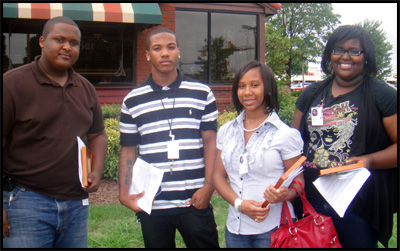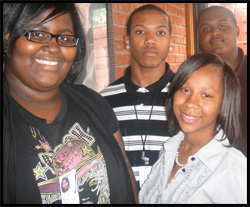CERSER PROGRAM/ NASA LANGLEY INTERNSHIP PROGRAM
My name is DeAndre Carswell, and I just graduated from I.C. Norcom High School last June. I will attend Old Dominion University in the fall, to major in Mechanical Engineering, and to minor in Aerospace Engineering. Last year, my Honors Physics teacher; Mr. Daron Moore introduced us to a program that was going on this summer where kids got the chance to work at NASA Langley Research Center for 8 weeks. The opportunity that was presented to the class seemed somewhat too good to be true. I just knew I had to take advantage of it, and to submit my resume and to fill out all the forms.
As time went by, I was told that I received the paid internship. I was quite overjoyed and was anxious to see what we would exactly be doing inside the Research Center. So as the end of June came, the time came to wake up and head to Hampton, VA. The first day I arrived with my other co-workers, we took a tour of the NASA Langley Research Center.
 Langley was the initial home of the first astronauts, of Mercury 7. Now the Center is working to design and test a new launch abort system for the next generation space capsules. Solving the tough problems in air, space and earth science is what Langley is known for. Its reputation for exceptional research started soon after Langley was established as the United States' first civilian aeronautics laboratory in 1917. Researchers at Langley are focusing on some of the biggest technical challenges of our time: global climate change, access to space and revolutionizing airplanes and the air transportation system. Langley was the initial home of the first astronauts, of Mercury 7. Now the Center is working to design and test a new launch abort system for the next generation space capsules. Solving the tough problems in air, space and earth science is what Langley is known for. Its reputation for exceptional research started soon after Langley was established as the United States' first civilian aeronautics laboratory in 1917. Researchers at Langley are focusing on some of the biggest technical challenges of our time: global climate change, access to space and revolutionizing airplanes and the air transportation system.
Langley scientists study the atmosphere to improve life here on Earth and to better understand the conditions planes and spacecraft fly through. Langley engineers work on technologies to make civilian and military planes safer, quieter and more efficient, while designing tomorrow's supersonic and even hypersonic aircraft. Langley researchers analyze materials and structures to help spacecraft withstand unforgiving extraterrestrial environments. NASA Langley's decades of contributions in aerospace, atmospheric sciences and technology commercialization are engineering a better future for all of us. Some of the benefits may surprise you says Lesa Roe; Director of NASA Langley Research Center.
We met Mr. Charlie Harris; who is the head of the Logistics Management Department, his assistant Mrs. Suzanne Melson, and some of their coworkers. Mrs. Melson was responsible for securing computers, desk, and other office supplies for us. Each one of us had our own desks, with computers, pencils, notepads, and other things that we might have needed for work. But, Lamar Hike and I got the privilege to work in the hangar.
At the time, neither one of us knew what the hangar was until we arrived there. We were given a safety tour by Mr. Wayne Lee; who is the head for Aircraft Systems Integration at Langley Research Center. On the safety tour, we were walked around the entire airplane hangar, and also the office command modules. These modules were home to some of the top scientists and engineers in the world. I had asked, why were they considered at the top? And Mr. Wayne Lee described to us, how they were in the process of designing STS Missions to the Moon, and also the Martian Planet. On their desks and in the hallways, were continuous pictures on each space shuttle, and the plan configuring each separate mission. I got the chance to talk to the project manager, who had eleven different degrees from some of the top institutions this nation has to offer. After viewing the executive offices, we were taken into a room which had a keypad lock, and also a security badge scanner. I thought to myself this must be the site of highly protected treasures of the United States Government. It was revealed to us that it was, and we were in the presence of almost ten airplanes.
Some of the airplanes included, a T-38 Northrop jet; which had just come in from the Kennedy Space Center in Florida. This aircraft is a two seat, supersonic trainer, which is used constantly by astronauts who are training for future missions. It is also used for mission support flights for Air force and Navy pilots. In the airplane hangar was also three special aircrafts named the OV-10’s. These were once actual NAVY airplanes, but were bought out from the National Aeronautics and Space Administration. It is also special in its own way, because of its night observation and target market system. Even though this aircraft consists of mostly military combat research weapons, it is until this day being worked on to make it a full fledge NASA Research plane. When we first arrived at Langley there were planes missing that belonged in the Space Centers’ hangar. Once they eventually arrived in the middle weeks of the internship, we were introduced to them. One was the B-200, which takes atmospheric data from low pressure valves in its twin engines. What stood out about this airplane are its trips that it took around the world. This aircraft had visited eighteen different nations, and seven islands including the Bahamas. It is also the only NASA Research plane to take data and readings from the recent oil spill that has devastated the Gulf-Coast region of the United States. It has been commended also by President Barak Obama, for its’ diligence and hard work in learning more about the atmosphere that we breathe in every day. The last airplane that appealed to me mostly was the WB-57. This airplane might just seem dull to some, but it’s quite remarkable. There are only three left in the entire world, which makes it certainly endangered. NASA owns only two and the Europeans the other. This aircraft is a mid-wing, long range research plane capable of extended periods of flight. Two crewmembers can fit into this airplane’s cockpit. This aircraft can carry up to 6000 lbs. of payload, not including atmospheric instruments used for its sensing capabilities. Located beside this airplane, were hundreds of people passing through on a daily basis. Their main purpose was to fix the navigation, and sensing programs which consisted in the aircraft subsystems. Wherever the aircraft traveled to around the globe, these same people accompanied it.
 Each one of the airplanes had a separate workstation with it, where the aircraft mechanics would work on them. To the Aircraft Mechanics these seemed to them as collectable toys that they all treasured. Although, we didn’t get the chance to work with the aircraft, we did work with the parts and equipment that were needed for each aircraft to function. Each one of the airplanes had a separate workstation with it, where the aircraft mechanics would work on them. To the Aircraft Mechanics these seemed to them as collectable toys that they all treasured. Although, we didn’t get the chance to work with the aircraft, we did work with the parts and equipment that were needed for each aircraft to function.
Our job was located in the stock room, where I met one of the most inspirational men, in my life to date. His name was Mr. Freddie Bynum, not only did he tell us things about the job world, who also told us about the real world. He seemed to relate to us in many ways, which were unexplainable. This man had been in the NAVY for the last twenty years upon retiring. He had worked on two United States Commissioned ships, including the U.S.S. WASP; which is a multipurpose amphibious assault ship. And also he has worked on the U.S.S Kennedy; which was the last American non-nuclear powered aircraft carrier ever have to been built. His tasks on both of these ships, was to be the Head Aviation Supply Clerk. As you can tell by his duties he has remarkably travelled around the world. Mr. Freddie Bynum quotes from time to time: “You can’t fly without supply.” Day to day we counted each of the parts off of an Aircraft Supply List; which hadn’t been organized within years. We would inventory the parts, seal them in a bag, and label them according to the system that NASA uses for Logistics called NAMIS.
Everyday walking to the stock room, we had to cross the airplane hangar floor, I personally got the chance to meet astronauts, pilots, engineers, scientists, and some of the top dogs in the Aerospace field. I even got the chance to see a rare T-38 NASA jet and WB-57 in the hangar, which was coming in from the Houston Space Center. Out of all the things that I had witnessed working in this program; the Air Forces’ fighter jets taking off, the engineers working on blue prints, the friendships made, the networking that was possible, the CEO’s that we were introduced to, the pilots that shook my hand, and the mid-day discussions with Mr. Freddie Bynum, it was inspirational. I noticed that these people that worked for the National Aeronautics and Space Administration were some of the most down-to-Earth, ordinary people that I have ever come in contact with.
I already had my aspirations set for the future; which was to go to college and receive my Doctoral Degree in Aerospace Engineering then become an American Astronaut. This program, that you let me be a part of has touched me in many ways, which I can’t begin to speak of; and it has reassured me that I am going to be the First African-American to ever set foot on the Moon. Thank you for letting me, have this priceless opportunity. Like Mr. Freddie Bynum has said to us many times during the course of this internship, “Programs like yours, give the younger generation the guarantee that someone is actually out there to help us endeavor to reach among the stars, and to grab our dreams.” |

